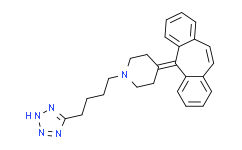| DC48172 |
BAY-6672
|
BAY-6672 is a potent and selective human Prostaglandin F (FP) receptor antagonist with an IC50 value of 11 nM. |
| DC10475 |
Grapiprant
|
Grapiprant is a selective EP4 receptor antagonist whose physiological ligand is prostaglandin E2 (PGE2) |
| DC8348 |
TG6-10-1
|
TG6-10-1 is a cell-permeable,highly potent, selective, and competitive antagonist of prostaglandin E2 receptor (EP2, Kb = 17.8 nM). |
| DC9609 |
Terutroban
|
Terutroban is a thromboxane/prostaglandin endoperoxide receptor antagonist.
|
| DC8624 |
Setipiprant(ACT129968)
|
Setipiprant is an orally available, selective CRTH2 antagonist. CRTH2 is a G protein-coupled receptor for PGD2. |
| DC8353 |
PF-04418948
|
PF-04418948 is an orally active, potent, and selective EP2 receptor antagonist (IC50 = 16 nM). |
| DC11043 |
Omidenepag
|
Omidenepag is a potent, selective agonist human EP2 receptor with binding IC50/EC50 of 10/1.7 nM, >500-fold selectivity over EP1, EP3 and EP4 receptors; Omidenepag is the active form of Omidenepag Isopropyl (OMDI). |
| DC10437 |
MRE-269
|
MRE-269 is an active metabolite of selexipag, and acts as a selective IP receptor agonist. |
| DC10785 |
MK-7246
|
MK-7246 is a potent and selective CRTH2 antagonist with a Ki of 2.5±0.5 nM. |
| DC1009 |
Laropiprant
|
MK 0524 is a potent, selective DP1 receptor antagonist with Ki values of 0.57 nM and 0.75 µM for the DP1 and DP2 receptors, respectively. |






















